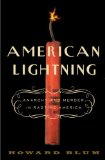Summary | Excerpt | Reviews | Beyond the Book | Readalikes | Genres & Themes | Author Bio
Terror, Mystery, the Birth of Hollywood, and the Crime of the Century
by Howard Blum

Critics' Opinion:
Readers' Opinion:
First Published:
Sep 2008, 352 pages
Paperback:
Oct 2009, 352 pages
 Book Reviewed by:
Book Reviewed by:
Jamie Kuhns
Buy This Book
Chapter One
It was nearly midnight on September 4, 1910, in Peoria, Illinois, when the dark sky above the train yard opened and a pelting rain suddenly poured down. Surprised, the night watchman ran to a boxcar for shelter. That decision saved his life. He was safely inside when the bomb exploded. It was a clock bomb, rather crudely made but fueled by ten gallons of nitroglycerin. It had been placed under a nearby railway car transporting an eighty-ton girder.
The force of the blast knocked the watchman to the boxcar’s wooden floor. Outside the girder shot high into the sky. Shards of metal showered down, spears falling like iron lightning bolts amid the hard, hammering rain.
Within hours the president of the McClintic-Marshall Iron Works, the company that had fabricated the girder for a bridge being built across the Illinois River, hired the Burns Detective Agency to investigate the blast. A local Burns operative left his bed and hurried to the scene. Under a freight car carrying a second huge girder, he discovered a clock bomb that had failed to explode; the battery had lost its voltage. The clock had also been set for 11 hours and 59 minutes and 59 seconds. This would’ve allowed sufficient time for any escape. The culprits would be long gone, and, he anticipated, difficult to trace.
Outside the yard he found an empty nitroglycerin can and a small, neatly piled hill of sawdust. He brought the can and the unexploded bomb to the attention of the Peoria police captain at the scene. The captain glanced at the device, shook his head in a gesture of disgust at the criminals who had planted it, and then walked off to interview the night watchman.
Later, after the police had left, the Burns man retrieved the can and the bomb. He also gathered up the sawdust particles. He put all the evidence—the nitroglycerin can, the unexploded bomb, and the sawdust— into a large box and sent it to the agency’s headquarters in Chicago.
For weeks the box sat on a shelf in the evidence room, ignored and unopened. It was only after the events in Los Angeles that Billy Burns began to suspect its significance.
Chapter Two
California, here we come! Over the hills and across the valleys of America, from the icy, windswept prairies and the snowbound farmlands of the Midwest, people flocked to Los Angeles. As the twentieth century began, the city’s chamber of commerce spread the word that sunshine would cure any illness, that ripe oranges hung from trees ready for the taking, and that fortunes could be made buying and selling parcels of land. The California Dream captured people’s imagination, and day after day Southern Pacific and Santa Fe railroad cars filled with newcomers arrived at the Los Angeles station. In just a generation, this pueblo village dozing in the sunshine began to take shape as a city. By 1910 its population approached 900,000, and people were still pouring in. And as the city grew, as its inhabitants prospered, Los Angeles became a battleground.
It was a battle that was being fought all across America. In western mines, in New England mills, in New York sweatshops, in railroad cars traversing the nation, labor raged against capital. The nation was locked in a class struggle that threatened to erupt into the next civil war.
At one noncompromising extreme were unions such as the Industrial Workers of the World (IWW). They urged “direct action.” Sabotage, violence—these were acceptable, even necessary, political weapons. The goal was to place “the working class in possession of the economic power, the means of life, in control of the machinery of production and distribution, without regard to capitalist masters.” For these radical unionists, “there can be no harmony between employer and employee.”
Excerpted from American Lightning by Howard Blum. Excerpted by permission of Crown, a division of Random House, Inc. All rights reserved. No part of this excerpt may be reproduced or reprinted without permission in writing from the publisher.





The House on Biscayne Bay
by Chanel Cleeton
As death stalks a gothic mansion in Miami, the lives of two women intertwine as the past and present collide.

The Flower Sisters
by Michelle Collins Anderson
From the new Fannie Flagg of the Ozarks, a richly-woven story of family, forgiveness, and reinvention.

The Funeral Cryer by Wenyan Lu
Debut novelist Wenyan Lu brings us this witty yet profound story about one woman's midlife reawakening in contemporary rural China.
Your guide toexceptional books
BookBrowse seeks out and recommends the best in contemporary fiction and nonfiction—books that not only engage and entertain but also deepen our understanding of ourselves and the world around us.